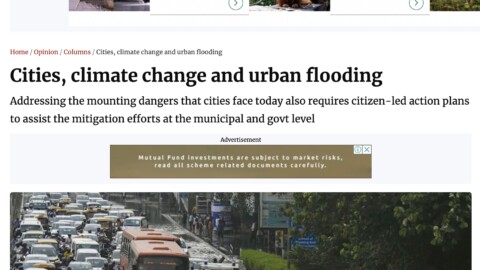By Dr. Bibek Debroy, Amit Kapoor and Aditya Sinha
Urban density, the concentration of people within a specific urban area, is becoming a palpable concern, especially in countries like India where rapid urbanization and population growth are intertwined. India’s metropolitan areas, like Mumbai and Delhi, are emblematic of this swelling issue. Prominent scholars such as Edward Glaeser, in his influential book “Triumph of the City”, have accentuated the pros and cons of urban density. He argues that while density can foster innovation, collaboration, and economic growth, it can also strain infrastructure, environment, and most crucially, housing. This is palpably depicted in movies like “Gully Boy”, where the protagonist’s life is significantly shaped by the cramped and constrained environment of Mumbai’s slums. The challenges brought on by urban density have invariably led to a serious re-evaluation of India’s urban planning policies.
Specifically, housing constraints have become pronounced because of strict regulations tied to the Floor Space Index (FSI) and the Floor Area Ratio (FAR). FSI denotes the ratio achieved by dividing the total Built-Up Area (BUA) of every level by the plot area. To illustrate, an FSI of 1 on a plot of 100 sqm means 100 sqm of BUA. Similarly, FAR is a concept akin to FSI. An FSI value of 1 can equivalently be expressed as 100% FAR. Typically, the building envelope is regulated by the Development Control Regulations (DCR) of a city, dictating the FSI, the maximum extent of ground the building can cover, the maximum height or number of floors permissible, required building setbacks and margins, mandated open spaces, minimum parking provisions, among other specifications.
These measures, which dictate the built-up area relative to the size of the plot, have often been criticized for being outdated and restrictive, especially in the Indian context. Their inflexibility exacerbates housing shortages and often indirectly encourages unauthorized constructions. Reforming these metrics is essential if India wishes to develop sustainable and inclusive cities. Recognizing and addressing these constraints, renowned urban theorist Jane Jacobs in her seminal work “The Death and Life of Great American Cities” highlighted the importance of adaptability in urban planning. Similarly, for India to tackle its urban density and housing challenge effectively, a paradigm shift in its approach to FSI and FAR regulations is imperative.
In the early 1900s, the rise of skyscrapers and increasing population density in urban areas of the USA necessitated the regulation of building forms to ensure access to light, air, and to maintain public safety. This led to the introduction of zoning laws, with the 1916 Zoning Resolution in New York City being one of the earliest instances of such regulations. These laws were designed to control the height and bulk of buildings, ensuring streets received adequate sunlight and air. Over time, these initial regulations evolved into the contemporary concepts of FSI or FAR. After World War II, the United States experienced significant urban expansion and economic growth, necessitating the need for evolved urban planning tools like land-use zoning and FAR to manage the profound urban development.
India embarked on its journey of urban planning post-independence in 1947, feeling the imperative need for planned urban development as cities started experiencing population and economic growth. The Bombay Town Planning Act, 1954, marked the introduction of the first town planning act in the country. India adopted the concept of FSI, understanding the benefits of standardized metrics to regulate urban development and strike a balance between built-up areas and open spaces, aiming for orderly growth, efficient infrastructure development, and prevention of unorganized construction. Over the decades, FSI became a pivotal component in the DCR formulated by different cities in India. However, it is crucial to acknowledge that the implementation and permissible FSI significantly vary across Indian cities due to the diverse nature of urban development challenges prevalent in the country.
A report by NITI Aayog in 2017, titled “India: Three Year Action Agenda“, shed light on a pressing concern. The permissible FSI in Indian cities is remarkably restricted, with values oscillating between 1 to 1.5. This limitation has led to a conspicuous absence of towering structures in our urban landscapes. Taking Mumbai as an example, its geographic layout bears significant resemblance to iconic skylines like Manhattan and Singapore. Yet, Mumbai’s skyline remains stunted in comparison. One can’t help but realize that by granting a more flexible FSI, we can significantly amplify our utilization of urban spaces, mirroring the growth and development witnessed in international counterparts.
Further, FSI is known to significantly vary across different cities in India and even within the same city, reflecting disparities in developmental control. For instance, central urban areas often have different FSI limits compared to peripheral areas, leading to uneven development and land use.
Moreover, several cities are undergoing rapid expansion, and builders are constructing buildings on the outskirts of cities to accommodate this growth. However, these outskirts are often not classified as urban due to the prevailing definitions of urban and rural areas, which are based on outdated criteria. The discrepancies in classification bring forth the urgent need to revisit and revise the definition of urban and rural areas in India. Many areas, despite showcasing urban characteristics such as high population density and predominant non-agricultural employment, are still classified as rural. This mismatch affects the application of FSI and hampers optimal land utilization, leading to haphazard and unorganized growth.
To resolve the issues arising from discrepancies in FSI and urban-rural classification, there is an imperative need to take three steps. (1) A comprehensive reevaluation and update of the criteria defining urban and rural areas to reflect the current realities and accommodate the evolving urban landscape in India. (2) A thoughtful revision of FSI limits to ensure uniformity and consistency across urban extents and outskirts, allowing for optimal and sustainable land use and development. (3) Formulation and implementation of inclusive urban planning policies that consider the expanding city peripheries and enable well-integrated and balanced development.
Given the challenges presented by rapid urbanization and increasing housing demands in Indian cities, the Government of India has acknowledged the crucial role of optimizing FSI in facilitating urban development. Recognizing this, various state governments are actively reviewing and modifying FSI regulations to align with the evolving urban landscape and developmental needs. Initiatives to ease norms have been notable, with states relaxing FSI norms, particularly in core city areas, aiming to promote vertical growth and accommodate the burgeoning population. Furthermore, the central government’s emphasis on affordable housing, especially under the Pradhan Mantri Awas Yojana (PMAY), has incentivized many states to offer additional FSI to developers, fostering the development of affordable housing projects.
In addition to addressing housing needs, innovative approaches like Transit-Oriented Development (TOD) are being proposed, allowing higher FSI around transit corridors, promoting optimal land use and encouraging public transport usage to alleviate vehicular congestion. Regular consultations with urban planners, developers, and various stakeholders are being conducted to recalibrate FSI norms, ensuring harmonization with the city’s infrastructural capacities and developmental aspirations. The integration of digital platforms in some states facilitates improved visualization and management of city plans, including FSI allocations, contributing to more coherent and sustainable urban development. Moreover, the ongoing reviews of FSI regulations are increasingly considering environmental implications, ensuring alignment with eco-friendly practices and balancing development with environmental conservation.
The ongoing urbanization and city expansions in India necessitate a proactive stance by states in reviewing FSI in cities, as it’s paramount to achieving balanced and sustainable urban development. FSI, being a crucial regulatory tool, determines the extent of built-up area permissible on a plot, impacting the urban density, land utilization, and skyline. The varying needs of growing cities, with escalating housing demands, urban amenities, and infrastructural developments, warrant periodic assessments and recalibration of FSI norms. States must endeavor to address the discrepancies in FSI allocations to harmonize it with the evolving urban morphology and to mitigate the issues of haphazard developments and urban sprawls.
Additionally, states should integrate environmental considerations, public infrastructure capacities, and urban resilience in FSI reviews to foster cities that are not only growth-oriented but also sustainable, inclusive, and resilient. A more nuanced and responsive approach to FSI could significantly contribute to shaping the cities’ future, enhancing the quality of urban life, and propelling overall urban progress.
Bibek Debroy is Chairman, Economic Advisory Council to the Prime Minister. Amit Kapoor is Chair, Institute of Competitiveness, India; Lecturer, Stanford University. Aditya Sinha is OSD, Research, Economic Advisory Council to the Prime Minister.
The article was published with Business World on September 30, 2023
























